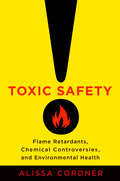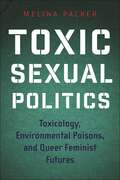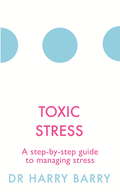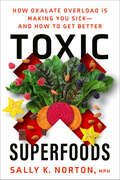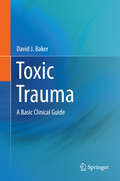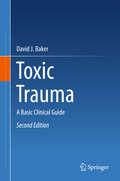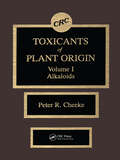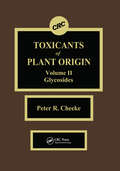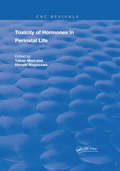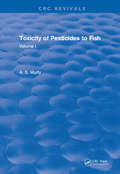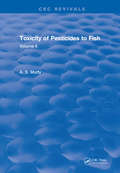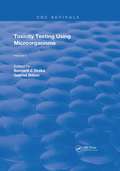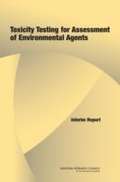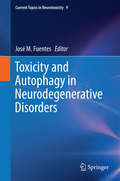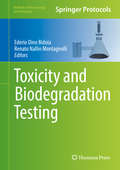- Table View
- List View
Toxic Safety: Flame Retardants, Chemical Controversies, and Environmental Health
by Alissa CordnerInitially marketed as a life-saving advancement, flame retardants are now mired in controversy. Some argue that data show the chemicals are unsafe while others continue to support their use. The tactics of each side have far-reaching consequences for how we interpret new scientific discoveries.An experienced environmental sociologist, Alissa Cordner conducts more than a hundred interviews with activists, scientists, regulators, and industry professionals to isolate the social, scientific, economic, and political forces influencing environmental health policy today. Introducing "strategic science translation," she describes how stakeholders use scientific evidence to support nonscientific goals and construct "conceptual risk formulas" to shape risk assessment and the interpretation of empirical evidence. A revelatory text for public-health advocates, Toxic Safety demonstrates that while all parties interested in health issues use science to support their claims, they do not compete on a level playing field and even good intentions can have deleterious effects.
Toxic Sexual Politics: Toxicology, Environmental Poisons, and Queer Feminist Futures (Health, Society, and Inequality)
by Melina PackerA bold exposé of how the very foundation of toxicology has been contaminated by sexist and racist ideologiesThe first critical understanding of the field of toxicology from a feminist and antiracist perspective, Toxic Sexual Politics asserts that the science of toxicants must be held accountable for the uneven distribution of toxic pollution along racial and sexual lines. Drawing upon in-depth interviews and extensive ethnographic and archival research, including participant observations in toxicology classrooms, conferences, and laboratories, Melina Packer urges environmental health advocates to place toxicant science within its masculinist, militarist, and eugenicist history.Toxic Sexual Politics shows how the founding fathers of U.S. toxicology were ideologically aligned with the chemical industry, inventing a science that could “make chemicals safe,” as opposed to one that could adequately protect planetary health from toxicants’ hazards. While many toxicologists today are critical of the chemical industry, they continue to rely on the highly limited tools of toxicology as accurate measures of toxicity, as do government regulators, the courts, and environmental advocates.Unlike most critiques of the chemical industry and narratives of environmental health movements, Toxic Sexual Politics refuses to take the science at face value. By focusing on the sexist, racist, and ableist biases reinforced by toxicology, Packer powerfully argues that this scientific discipline reproduces the very same white supremacist and heterosexist logics that generated environmental injustices in the first place. The field of toxicology can explicitly confront chemical corporate power by building from queer, feminist, anti-ableist, and antiracist movements for environmental and reproductive justice.
Toxic Stress: A step-by-step guide to managing stress (The Flag Series #5)
by Dr Harry Barry'This is a truly ground-breaking, innovative and profoundly enlightening work. Dr Harry Barry leads the reader on a holistic journey through the mind and its emotional responses in a way that is both explorative and explanatory' National Counselling Institute of Ireland'It's that rare thing - a medical book that can be read by lay people and health professionals alike. Dr Barry demystifies subjects that touch so many of our lives and he does so with compassion, wisdom and vast professional knowledge' Cathy Kelly, bestselling author and UNICEF ambassadorIdentify and manage stress with this practical, seven-step programme by bestselling author and GP, Dr Harry BarryIn the world we live in, stress comes from a multiple number of sources, including pressures at work, relationship difficulties and illness. Most people can usually take what life throws at them; but when stress builds up, it can overwhelm an individual and lead to potentially serious health problems. Toxic stress is an indispensable tool on coping with the stresses of modern life. By identifying the different kinds of stress and in particular the dangers of 'toxic' stress, Dr Barry shows us how to discover where our stress is coming from and how we can effectively confront, manage and reduce it in our lives.Previously published as Flagging Stress: Toxic Stress and How to Avoid It, this edition has been fully revised and updated.
Toxic Superfoods: How Oxalate Overload Is Making You Sick--and How to Get Better
by Sally K. NortonAn acclaimed nutrition educator reveals how the foods you&’re eating to get healthy might be making you sick. &“Sally Norton&’s well-researched book makes a truly important contribution to the literature in revealing just how much oxalates can damage the human body.&”—Nina Teicholz, author of The Big Fat Surprise If you&’re eating a healthy diet and you&’re still dealing with fatigue, inflammation, anxiety, recurrent injuries, or chronic pain, the problem could be your spinach, almonds, sweet potatoes, and other trusted plant foods. And your key to vibrant health may be quitting these so-called superfoods. After suffering for decades from chronic health problems, nutrition educator Sally K. Norton, MPH, discovered that the culprits were the chemical toxins called oxalates lurking within her &“healthy,&” organic plant-heavy diet. She shines light on how our modern diets are overloaded with oxalates and offers fresh solutions including: • A complete, research-backed program to safely reverse your oxalate load • Comprehensive charts and resources on foods to avoid and better alternatives • Guidance to improve your energy, optimize mood and brain performance, and find true relief from chronic pain In this groundbreaking guide, Norton reveals that the popular dictum to &“eat more plants&” can be misleading. Toxic Superfoods gives health-seekers a chance for improved energy, optimum brain performance, graceful aging, and true relief from chronic pain.
Toxic Trauma
by David J. BakerThis book provides practical guidance to emergency personnel and others in the event of having to manage individual or mass chemical casualties as part of their work in a civilian ambulance service or hospital. The text considers the nature and basic science of the hazards faced as well as the practical management of persons exposed to chemicals and toxins (which although of biological origin behave as chemicals in terms of their effects and transmission). Individual chapters cover the development and classification of chemical toxic agents, how exposure can occur and how medical personnel should be involved in its management . There is also consideration of the nature of toxic trauma and the pathophysiological processes involved, together with a systematic approach to early and continuing management supported by specific examples of incidents. This guide is a useful practical resource for emergency medical and paramedical personnel involved in the management of mass chemical casualties and with ensuring safe operating procedures within potentially contaminated areas to prevent secondary casualties from a chemical release.
Toxic Trauma
by David J. BakerThis second edition will update readers about recent chemical agent events and address the often misrepresented relationship between chemical and biological, radiological, and nuclear weapons; this text will go beyond existing information on poisoning and clinical toxicology to provide emergency personnel and others with a holistic approach to the increasing likelihood of having to manage individual or mass exposure to industrial and chemical warfare agents as well as to work safely and avoid the risks presented to medical and nursing personnel from secondary contamination. The exposure to toxic substances can affect all systems of the body causing many pathophysiological pathways of damage that converge with those identified in conventional physical trauma, in which then, these compounded symptoms can be identified as toxic trauma. The text considers the nature and basic science of these hazards as well as the practical management of persons exposed to chemicals and toxins with unfamiliar medical conditions and who require urgent treatment (which, although the conditions are of biological origin, they behave as chemicals in terms of their effects and transmission). The approach taken will be essentially clinically--based but with explanations of the underlying mechanisms that unify the syndromes with which victims present. Mirroring the format of the first edition, individual chapters cover the development and classification of chemical toxic agents, how exposure can occur and how medical personnel should be involved in its management. There is also consideration of the nature of toxic trauma and the pathophysiological processes involved, together with a systematic approach to early and continuing management supported by specific examples of incidents. This guide is a useful practical resource for emergency medical and paramedical personnel involved in the management of mass chemical casualties and with ensuring safe operating procedures within potentially contaminated areas to prevent secondary casualties from a chemical release.
Toxic War: The Story of Agent Orange
by Peter SillsThe war in Vietnam, spanning more than twenty years, was one of the most divisive conflicts ever to envelop the United States, and its complexity and consequences did not end with the fall of Saigon in 1975. As Peter Sills demonstrates in Toxic War, veterans faced a new enemy beyond post-traumatic stress disorder or debilitating battle injuries. Many of them faced a new, more pernicious, slow-killing enemy: the cancerous effects of Agent Orange.Originally introduced by Dow and other chemical companies as a herbicide in the United States and adopted by the military as a method of deforesting the war zone of Vietnam, in order to deny the enemy cover, Agent Orange also found its way into the systems of numerous active-duty soldiers. Sills argues that manufacturers understood the dangers of this compound and did nothing to protect American soldiers.Toxic War takes the reader behind the scenes into the halls of political power and industry, where the debates about the use of Agent Orange and its potential side effects raged. In the end, the only way these veterans could seek justice was in the court of law and public opinion. Unprecedented in its access to legal, medical, and government documentation, as well as to the personal testimonies of veterans, Toxic War endeavors to explore all sides of this epic battle.
Toxic War: The Story of Agent Orange
by Peter SillsThe war in Vietnam, spanning more than twenty years, was one of the most divisive conflicts ever to envelop the United States, and its complexity and consequences did not end with the fall of Saigon in 1975. As Peter Sills demonstrates in Toxic War, veterans faced a new enemy beyond post-traumatic stress disorder or debilitating battle injuries. Many of them faced a new, more pernicious, slow-killing enemy: the cancerous effects of Agent Orange. Originally introduced by Dow and other chemical companies as a herbicide in the United States and adopted by the military as a method of deforesting the war zone of Vietnam, in order to deny the enemy cover, Agent Orange also found its way into the systems of numerous active-duty soldiers. Sills argues that manufacturers understood the dangers of this compound and did nothing to protect American soldiers.Toxic War takes the reader behind the scenes into the halls of political power and industry, where the debates about the use of Agent Orange and its potential side effects raged. In the end, the only way these veterans could seek justice was in the court of law and public opinion. Unprecedented in its access to legal, medical, and government documentation, as well as to the personal testimonies of veterans, Toxic War endeavors to explore all sides of this epic battle.
Toxicant-Receptor Interactions: Modulations of signal transduction and gene expression (Target Organ Toxicology Series)
by A.M.O. MohamedMany of the toxic effects elicited by xenobiotics can be explained at the molecular level by their interaction with receptors or by disruption or interference with receptor-mediated signal transduction pathways. This volume describes molecular approaches and reviews of current research. It provides reviews of numerous research areas which are direc
Toxicants of Plant Origin: Alkaloids, Volume I
by Peter R. CheekeThis comprehensive treatise offers an in-depth discussion of natural toxicants in plants, emphasizing their effects as defenses against herbivory. Coevolution of plants and her-bivores are covered with a detailed treatment of toxicant metabolism and systemic effects in mammalian tissues. Con-sideration of the economic importance of plant toxins, modi-fication by plant breeding, management of toxico-sis, and toxicant problems in various geographic areas are in-cluded. Each volume offers an extensive description of chemistry, biosynthesis, analysis, distribution in plants, metabolism in mam-mals and insects, and practical problems in humans and livestock.
Toxicants of Plant Origin: Glycosides, Volume II
by Peter R. CheekeThis comprehensive treatise offers an in-depth discussion of natural toxicants in plants, emphasizing their effects as defenses against herbivory. Coevolution of plants and her-bivores are covered with a detailed treatment of toxicant metabolism and systemic effects in mammalian tissues. Con-sideration of the economic importance of plant toxins, modi-fication by plant breeding, management of toxico-sis, and toxicant problems in various geographic areas are in-cluded. Each volume offers an extensive description of chemistry, biosynthesis, analysis, distribution in plants, metabolism in mam-mals and insects, and practical problems in humans and livestock.
Toxicants of Plant Origin: Phenolics, Volume IV
by Peter R. CheekeThis comprehensive treatise offers an in-depth discussion of natural toxicants in plants, emphasizing their effects as defenses against herbivory. Coevolution of plants and her-bivores are covered with a detailed treatment of toxicant metabolism and systemic effects in mammalian tissues. Con-sideration of the economic importance of plant toxins, modi-fication by plant breeding, management of toxico-sis, and toxicant problems in various geographic areas are in-cluded. Each volume offers an extensive description of chemistry, biosynthesis, analysis, distribution in plants, metabolism in mam-mals and insects, and practical problems in humans and livestock.
Toxicity Assessment: Methods and Protocols (Methods in Molecular Biology #2240)
by Carlos Manuel Marques Palmeira Danielle Palma de Oliveira Daniel Junqueira DortaThis book collects protocols from different areas of knowledge to assist in the identification of toxic effects exerted by different xenobiotics. At the same time as classical techniques are presented, modern techniques with alternative models to the use of animals are also presented. Given the ever-increasing exposure to different compounds and their effects on population health, the assessment of multiple endpoints is of utmost importance for better risk assessment, and this collection addresses that need. Written for the highly successful Methods in Molecular Biology series, chapters include introductions to their respective topics, lists of the necessary materials and reagents, step-by-step, readily reproducible laboratory protocols, and tips on troubleshooting and avoiding known pitfalls. Authoritative and practical, Toxicity Assessment: Methods and Protocols aims to serve researchers in this vast field of science as they seek to better understand the mechanisms of action of different xenobiotics.
Toxicity Of Hormones In Perinatal Life (Routledge Revivals)
by Takao Mori Hiroshi NagasawaFirst Published in 1988, this book offers a full, comprehensive guide into the toxicity of hormones during childbirth. Carefully compiled and filled with a vast repertoire of notes, diagrams, and references this book serves as a useful reference for students of midwifery, and other practitioners in their respective fields.
Toxicity Of Pesticides To Fish: Volume I
by A.S. MurtyThe present work is the first major attempt at reviewing comprehensively all the available information about the environmental fate and behaviour of the xenobiotic chemicals.
Toxicity Of Pesticides To Fish: Volume II
by MurtyThe present work is the first major attempt at reviewing comprehensively all the available information about the environmental fate and behaviour of the xenobiotic chemicals.
Toxicity Of Pure Foods (Routledge Revivals)
by E. M. BoydFirst Published in 1973, this book offers a full, comprehensive guide into the toxicology of certain foods. Carefully compiled and filled with a vast repertoire of notes, diagrams, and references this book serves as a useful reference for students of toxicology, and other practitioners in their respective fields.
Toxicity Testing Using Microorganisms (Routledge Revivals #1)
by Gabriel Bitton Bermard J. DutkaFirst Published in 1986, this two-volume set offers comprehensive insight into the testing of toxic substances using microorganisms as reference. Carefully compiled and filled with a vast repertoire of notes, diagrams, and references this book serves as a useful reference for students of medicine and other practitioners in their respective fields.
Toxicity Testing Using Microorganisms (Routledge Revivals #2)
by Gabriel Bitton Bernard J. DutkaFirst Published in 1986, this two-volume set offers comprehensive insight into the testing of toxic substances using microorganisms as reference. Carefully compiled and filled with a vast repertoire of notes, diagrams, and references this book serves as a useful reference for students of medicine and other practitioners in their respective fields.
Toxicity Testing for Assessment of Environmental Agents: Interim Report
by National Research Council of the National AcademiesToxicity testing in laboratory animals provides much of the information used by the Environmental Protection Agency (EPA) to assess the hazards and risks associated with exposure to environmental agents that might harm public health or the environment. The data are used to establish maximum acceptable concentrations of environmental agents in drinking water, set permissible limits of exposure of workers, define labeling requirements, establish tolerances for pesticides residues on food, and set other kinds of limits on the basis of risk assessment. Because the number of regulations that require toxicity testing is growing, EPA called for a comprehensive review of established and emerging toxicity-testing methods and strategies. This interim report reviews current toxicity-testing methods and strategies and near-term improvements in toxicity-testing approaches proposed by EPA and others. It identifies several recurring themes and questions in the various reports reviewed. The final report will present a long-range vision and strategic plan to advance the practices of toxicity testing and human health assessment of environmental contaminants.
Toxicity Testing in the 21st Century: A Vision and a Strategy
by National Research Council of the National AcademiesOnce dismissed by the medical profession as a purely cosmetic problem, obesity now ranks second only to smoking as a wholly preventable cause of death. Indeed, it's implicated in 300,000 deaths each year and is a major contributor to heart disease, diabetes, high blood pressure, high cholesterol, and depression. Even conservative estimates show that 15% of all children are now considered to be overweight--worldwide there are 22 million kids under five years old that are defined as fat. Supersized portions, unhealthy diets, and too little physical activity certainly contribute to what's making kids 'fat'. But that's not the whole story. Researchers are at a loss to explain why obesity rates have risen so suddenly and so steeply in the closing decades of the 20th century. But head out to the beaches, playgrounds, and amusement parks, and it's obvious that overweight children are more numerous and conspicuous. We see it in our neighborhoods and we read it in the headlines. Our nation--indeed the world--is in crisis. But knowledge is power and it's time to arm ourselves in the battle to win the war on obesity. Fed Up! is just what the doctor ordered. Based in part on the Institute of Medicine's ground-breaking report on childhood obesity, this new book from family physician and journalist Susan Okie provides in-depth background on the issue; shares heartrending but instructive case studies that illustrate just how serious and widespread the problem is; and gives honest, authoritative, science-based advice that constitute our best weapons in this critical battle.
Toxicity and Autophagy in Neurodegenerative Disorders
by José M. FuentesComprehensive overview of different aspects of autophagy as it relates to neurodegenerative diseases. The pathogenesis of the main neurodegenerative disorders includes either the accumulation of altered or misfolded proteins or exposure to several toxics. Autophagy constitute one of the two principal cellular pathways implicate in the clearance of these material and can serve as a neuroprotective mechanism. Topics include: the role of autophagy in the brain, the role of autophagy in the principal neurodegenerative disorders, and the mechanism by which different molecules cause neurotoxicity and the role autophagy plays.
Toxicity and Biodegradation Testing
by Ederio Dino Bidoia Renato Nallin MontagnolliThis volume presents a broad compendium of techniques used in biodegradation and toxicological research. Through both legacy and up-to-date approaches to practical methodologies with proven results, the book examines the role and applications of analytical biodegradation quantification as it applies to the environmental sciences, particularly in the range of byproducts that are usually linked to toxicology, and the test organisms most often used in toxicity testing. Topics include scientific and technical feasibility studies, contaminant impacts evaluation, study design and analytical techniques, key methodologies required to prepare the biodegradation and toxicology protocols, as well as the handling of microbial communities related to such processes. Written for the Methods in Pharmacology and Toxicology series, chapters deal with a critical discussion of laboratory scale experiments, as well as full scale in situ and ex situ apparatus, with each chapter containing both a discursive section along with a detailed methods section. Detailed and authoritative, Toxicity and Biodegradation Testing is primarily focused toward the environmental sciences researcher, while the range of techniques also provides an introduction to biodegradation and toxicology methods for researchers outside of the field.
Toxicity and Metabolism of Explosives
by Jehuda YinonThe purpose of this important monograph is to provide the reader with a better understanding of the toxicity, channels of absorption, and metabolism of explosives by the body. This one-of-a-kind work also incorporates the symptoms and clinical manifestations of poisoning by these compounds. It discusses how the disposal of explosives and their degr
Toxicity and Risk: Context, Principles and Practice
by H Paul IllingThis book aims to set out the political, social, legal and scientific underpinning of risk assessment and risk management for toxic substances. It describes the principles and processes the practitioners undertake when looking at the regulatory risk implications of their work.
